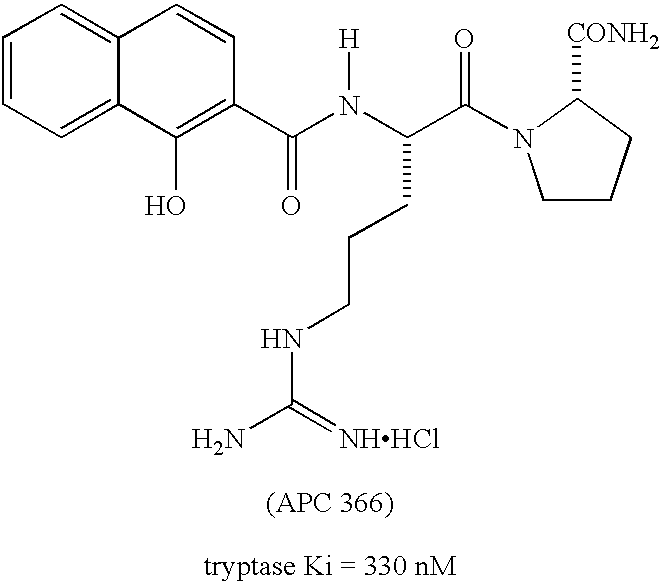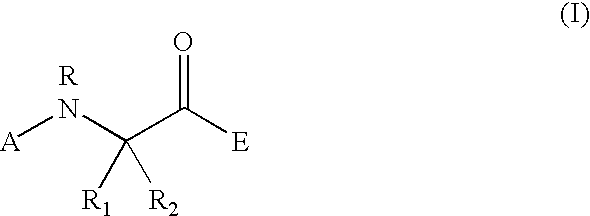Peptidyl heterocyclic ketones useful as tryptase inhibitors
a technology of tryptase inhibitors and peptidyl heterocyclic ketones, which is applied in the direction of peptides, drug compositions, immunological disorders, etc., can solve the problems that glucocorticoid administration also generates a litany of local and systemic side effects
- Summary
- Abstract
- Description
- Claims
- Application Information
AI Technical Summary
Benefits of technology
Problems solved by technology
Method used
Image
Examples
example 1
(2S,4R)-1-Acetyl-N-[(1S)-4-[(aminoiminomethyl)amino]-1-(2-benzothiazolylcarbonyl)butyl]-4-hydroxy-2-pyrrolidinecarboxamide
[0091]
[0092]Benzotriazol-1-yloxy-tris(dimethylamino)phosphonium hexafluoro-phosphate (BOP reagent;113.5 g, 0.256 mol) was added in one portion to a stirred solution of N-α-t-Boc-NG-(p-toluenesulfonyl)-L-arginine (Boc-Arg(Ts)—OH; 100 g, 0.233 mol), N,O-dimethylhydroxylamine hydrochloride (34.2 g, 0.350 mol), triethylamine (97 mL, 0.696 mol) in dry N,N-dimethylformamide (2.5 L) under argon at 5° C. The reaction mixture was allowed to slowly warm to room temperature over 1 h, filtered through diatomaceous earth and concentrated in vacuo at 60° C. The residue was dissolved in CH2Cl2 (1 L), washed sequentially with H2O, saturated aqueous NaHCO3 (2×), 1N HCl (2×), brine, dried (Na2SO4) and concentrated in vacuo to give a thick syrup. The syrup was recrystallized from ethyl acetate (300 mL) at room temperature over 16 h. The resulting white solid was isolated by filtrat...
example 2
(2S,4R)-1-Acetyl-N-[4-[(aminoiminomethyl)amino]-1-(2-benzothiazolylcarbonyl)butyl]4-hydroxy-2-pyrrolidinecarboxamide
[0105]
[0106]Compound 2 was prepared in the same way as described in Example 1 with the exception that both L- and D-arginine epimers were collected during the reverse-phase HPLC purification to afford a 1.1:1 mixture of epimers. The trifluoroacetate salt of 2 was converted to the HCl salt by dissolving it into 0.1 N aqueous HCl and concentrating in vacuo 3 times. The resulting glass was dissolved in water and lyophilized to afford the HCl salt of 2 as a light yellow solid; MS (ES) m / z 447 (MH+).
example 3
cis-2-Acetylamino-N-[(1S)-4-[(aminoiminomethyl)amino]-1-(2-benzothiazolylcarbonyl)butyl]-1-cyclopentanecarboxamide
[0107]
[0108]Benzotriazol-1-yloxy-tris(dimethylamino)phosphonium hexafluoro-phosphate (BOP reagent; 25.0 g, 56 mmol) was added in one portion to a stirring solution of N-α-t-Boc-NG-(4-methoxy-2,3,6-trimethylbenzenesulfonyl)-L-arginine (Boc-Arg(Mtr)-OH; 24.96 g, 51.3 mmol), N,O-dimethylhydroxylamine hydrochloride (7.6 g, 56 mmol), triethylamine (22 mL, 154 mmol) in dry N,N-dimethylformamide (100 mL) under argon at 0° C. The reaction mixture was allowed to slowly warm to room temperature over 2 h, filtered through diatomaceous earth, and concentrated in vacuo. The residue was dissolved in ethyl acetate, washed with H2O (3×), 1M aqueous KHSO4, saturated aqueous NaHCO3, brine, dried (Na2SO4) and concentrated in vacuo. The residue was purified by chromatography on silica gel eluted with ethyl acetate / CH2Cl2 (3:1) to give 3a as a white solid (see WO 9630396, Example 2).
[0109]
[0...
PUM
| Property | Measurement | Unit |
|---|---|---|
| temperature | aaaaa | aaaaa |
| temperature | aaaaa | aaaaa |
| temperature | aaaaa | aaaaa |
Abstract
Description
Claims
Application Information
 Login to View More
Login to View More - R&D
- Intellectual Property
- Life Sciences
- Materials
- Tech Scout
- Unparalleled Data Quality
- Higher Quality Content
- 60% Fewer Hallucinations
Browse by: Latest US Patents, China's latest patents, Technical Efficacy Thesaurus, Application Domain, Technology Topic, Popular Technical Reports.
© 2025 PatSnap. All rights reserved.Legal|Privacy policy|Modern Slavery Act Transparency Statement|Sitemap|About US| Contact US: help@patsnap.com



